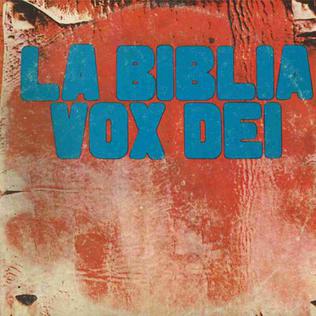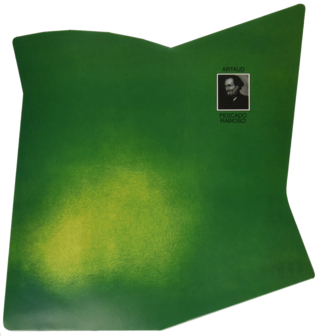
Carlos Alberto GarcíaMoreno, better known by his stage name Charly García, is an Argentine singer-songwriter, multi-instrumentalist, composer and record producer, considered one of the most important and avant-garde figures of Argentine and Latin American music. Named "the father of rock nacional", García is widely acclaimed for his recording work, both in his multiple groups and as a soloist, for the complexity of his music compositions, covering genres like folk rock, progressive rock, symphonic rock, jazz, new wave, pop rock, funk rock, and synth-pop. His lyrics are known for being transgressive and critical towards modern Argentine society, especially during the era of the military dictatorship, and for his rebellious and extravagant personality, which has drawn significant media attention over the years.
Argentine rock is rock music composed or performed by Argentine bands or artists mostly in Spanish.
Serú Girán was an Argentine rock supergroup. Formed in 1978, the group consisted of Charly García, David Lebón, Oscar Moro and Pedro Aznar the three first being already consecrated musicians through their previous bands. It is considered one of the best in the history of rock en español, both musically and conceptually, including the staging

Alejandro Federico Lerner is an Argentine musician and singer-songwriter. He has written and sung countless songs including several hits, and his fame and recognition spread all over South America.

Raúl Alberto Antonio Gieco, better known as León Gieco is an Argentine folk rock performer, composer and interpreter. He is known for mixing popular folkloric genres with Argentinian rock and roll, and lyrics with social and political connotations. This has led to him being called "The Argentine Bob Dylan".

PorSuiGieco y su Banda de Avestruces Domadas, also known as Porsuigieco or PorSuiGieco, was an Argentine folk rock supergroup consisting of Charly García, Nito Mestre, León Gieco, Raúl Porchetto and María Rosa Yorio. The band was active only in 1975. The only album that they released was Porsuigieco. They performed live only two times. After 1976, the band was dissolved. In 1978 they briefly reunited to play at a festival in Buenos Aires.

Porsuigieco is the only album by PorSuiGieco, a supergroup consisting of Charly García, Nito Mestre, León Gieco, Raúl Porchetto and María Rosa Yorio, released in 1976. In the first edition of the LP, the song "Antes de Gira" was substituted for a censured song: "El fantasma de Canterville". But, in 1993, the album was released with "El fantasma de Canterville" as bonus track. The album was recorded in only two weeks.

"Can We Still Be Friends" is a song written and originally performed by Todd Rundgren.

Raúl Porchetto is an Argentine musician and songwriter.

Vida (Life) is the debut album of Argentine rock group Sui Generis, released in 1972 by Microfón.

Confesiones de Invierno is the second album of Argentine rock group Sui Generis, released in 1973 by the Talent label.

Pequeñas anécdotas sobre las instituciones is the third album of Argentine group Sui Generis, released in 1974 by the Talent label.

La Biblia is the second studio album by the Argentine band Vox Dei, released as a double album on March 15, 1971 by Disc Jockey Records. Considered a milestone of nascent Argentine rock, as well as one of the first rock operas and concept albums of rock en español, La Biblia centers on the Bible's narrative, starting from Genesis and concluding with the Apocalypse.

Carlos Alberto Mestre mostly known by his stage name Nito Mestre, is an Argentine musician, founding member –along with Charly García– of Sui Generis, member of PorSuiGieco, bandleader of Nito Mestre y los Desconocidos de Siempre and a recording solo artist. Sui Generis, was initially formed in 1969 by Charly García, Nito Mestre, Rolando Fortich, Juan Belia (guitar), Alberto Rodriguez (drums) and Carlos Piegari (vocals). Later on, Sui Generis became a duo as everyone left except for García. After the band split in 1975, Nito Mestre formed a new band called "Nito Mestre y los Desconocidos de Siempre" with María Rosa Yorio on vocals, Rodolfo Gorosito on guitar, Alfredo Toth on bass, Ciro Fogliatta on keyboards and Juan Carlos "Mono" Fontana as a drummer. In the early 80s, Nito pursued a solo career.

Artaud is a studio album credited to Argentine rock band Pescado Rabioso, released in October 1973 on Talent-Microfón. It is essentially the second solo album by singer-songwriter Luis Alberto Spinetta, who used the group's name despite their disbandment earlier that year.

María Rosa Yorio is an Argentine painter, singer, songwriter, instructor and band leader.

Almendra is the self-titled debut studio album by Argentine rock band Almendra which was released in 1969 on Vik, a subsidiary of RCA Victor. To distinguish it from the band's next release, Almendra II, it is also known as Almendra I. The album represented the first full-length musical endeavour of nineteen-year-old Luis Alberto Spinetta, having formed the band in the mid 1960s along with Emilio del Guercio, Edelmiro Molinari and Rodolfo García. The famous artwork, showing a crying man with a toy arrow stuck on his head, was designed by Spinetta to embody the different lyrical themes of the album.
Sólo le pido a Dios is a famous protest song, written by Argentine singer-songwriter León Gieco. It is the first song of Gieco's 1978 album, IV LP.
G.I.T. is a supergroup of rock and new wave from Buenos Aires, Argentina, emerged in the early 1980s, composed of Pablo Guyot, Willy Iturri and Alfredo Toth. The 3 musicians coincided for the first time in Raúl Porchetto's band, serving as the instrumental basis for the best hits of the artist in the early 1980s. Charly García was dazzled with Porchetto's base and incorporated them into his solo band, recording with them 2 albums.
Federico José Moura was an Argentine singer, songwriter, record producer, fashion designer and lead vocalist of the new wave rock band Virus, formed with his brothers Julio and Marcelo in 1981. Moura is now regarded as one of the most recognizable and influential musicians of Spanish-language rock.















